PEP小学五年级英语教案设计(黄晓丹)--“教学中的互联网搜索”优秀教学案例评选_教案设计
PEP小学五年级英语下册全册教案
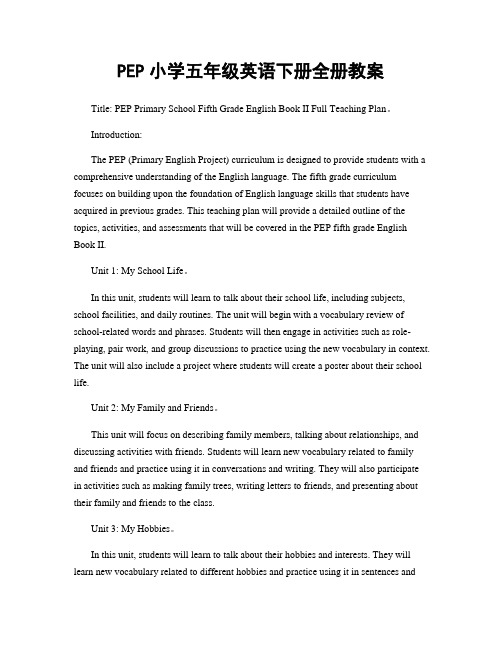
PEP小学五年级英语下册全册教案Title: PEP Primary School Fifth Grade English Book II Full Teaching Plan。
Introduction:The PEP (Primary English Project) curriculum is designed to provide students with a comprehensive understanding of the English language. The fifth grade curriculum focuses on building upon the foundation of English language skills that students have acquired in previous grades. This teaching plan will provide a detailed outline of the topics, activities, and assessments that will be covered in the PEP fifth grade English Book II.Unit 1: My School Life。
In this unit, students will learn to talk about their school life, including subjects, school facilities, and daily routines. The unit will begin with a vocabulary review of school-related words and phrases. Students will then engage in activities such as role-playing, pair work, and group discussions to practice using the new vocabulary in context. The unit will also include a project where students will create a poster about their school life.Unit 2: My Family and Friends。
PEP小学英语五年级下册教案(全册)
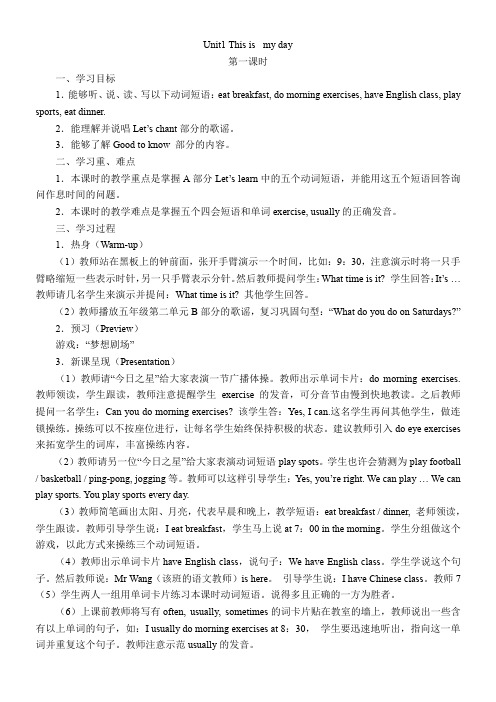
Unit1 This is my day第一课时一、学习目标1.能够听、说、读、写以下动词短语:eat breakfast, do morning exercises, have English class, play sports, eat dinner.2.能理解并说唱Let’s chant部分的歌谣。
3.能够了解Good to know 部分的内容。
二、学习重、难点1.本课时的教学重点是掌握A部分Let’s learn中的五个动词短语,并能用这五个短语回答询问作息时间的问题。
2.本课时的教学难点是掌握五个四会短语和单词exercise, usually的正确发音。
三、学习过程1.热身(Warm-up)(1)教师站在黑板上的钟前面,张开手臂演示一个时间,比如:9:30,注意演示时将一只手臂略缩短一些表示时针,另一只手臂表示分针。
然后教师提问学生:What time is it? 学生回答:It’s … 教师请几名学生来演示并提问:What time is it? 其他学生回答。
(2)教师播放五年级第二单元B部分的歌谣,复习巩固句型:“What do you do on Saturdays?”2.预习(Preview)游戏:“梦想剧场”3.新课呈现(Presentation)(1)教师请“今日之星”给大家表演一节广播体操。
教师出示单词卡片:do morning exercises.教师领读,学生跟读,教师注意提醒学生exercise的发音,可分音节由慢到快地教读。
之后教师提问一名学生:Can you do morning exercises? 该学生答:Yes, I can.这名学生再问其他学生,做连锁操练。
操练可以不按座位进行,让每名学生始终保持积极的状态。
建议教师引入do eye exercises 来拓宽学生的词库,丰富操练内容。
(2)教师请另一位“今日之星”给大家表演动词短语play spots。
人教版pep五年级英语下册unit5教学设计

人教版pep五年级英语下册unit5教学设计全文共3篇示例,供读者参考篇1Unit 5 of the People's Education Press (PEP) Fifth Grade English textbook covers the topic of "What did you do on vacation?" This unit focuses on past tense verbs and the concept of recounting past events. In this teaching design, I will outline a nine-lesson plan to cover the content of Unit 5 in an engaging and effective manner.Lesson 1: Introduction to Past TenseObjective: Introduce the concept of past tense verbs.Activities: Present sentences in present and past tense, have students identify the differences.Lesson 2: Past Tense Verbs (Simple Past)Objective: Teach the simple past tense of regular verbs.Activities: Practice regular past tense verbs through exercises and games.Lesson 3: Past Tense Verbs (Irregular Verbs)Objective: Introduce irregular past tense verbs.Activities: Have students memorize common irregular verbs and use them in sentences.Lesson 4: Asking and Answering QuestionsObjective: Teach students to ask and answer questions about past events.Activities: Role-play conversations about vacation activities using question words.Lesson 5: Writing about VacationsObjective: Practice writing short paragraphs about past vacation experiences.Activities: Provide prompts for students to write about their own vacations.Lesson 6: What Did You Do on Vacation?Objective: Teach the structure of past tense questions.Activities: Have students ask and answer questions about their vacations in pairs.Lesson 7: Listening ComprehensionObjective: Practice listening for specific information.Activities: Play recordings of vacation stories and ask questions based on the content.Lesson 8: Vocabulary ReviewObjective: Review key vocabulary words from Unit 5.Activities: Play vocabulary games like charades or Pictionary to reinforce learning.Lesson 9: Unit TestObjective: Assess students' understanding of Unit 5 content.Activities: Administer a written test covering past tense verbs, question formation, and vocabulary.Overall, this nine-lesson plan aims to help students grasp the concept of past tense verbs and effectively communicate about their past experiences. By incorporating interactive activities and games, students will stay engaged and motivated throughout the unit. The activities are designed to cater to different learning styles and promote active participation in the classroom.篇2PEP (Primary English Program) is a teaching material issued by the People's Education Press in China. PEP English textbooks are widely used in primary schools across the country. In thislesson plan, I will focus on Unit 5 from the fifth grade of the PEP English textbook.Unit 5 is titled "What Does She Look Like?" and the main topic of the unit is describing people's physical appearances. This unit includes vocabulary related to physical appearance such as hair, eyes, nose, etc. It also covers grammar points such as the verb "to be" and adjectives.Here is a detailed breakdown of the lesson plan for Unit 5:1. Warm-up (10 minutes)Start the lesson by reviewing the vocabulary related to physical appearances. Use flashcards or pictures to help students remember the words. You can also ask students to describe their own physical appearances to practice the vocabulary.2. Presentation (15 minutes)Introduce the grammar point "to be" and adjectives to describe people. Show examples on the board and explain how to use them in sentences. Encourage students to create their own sentences using the grammar point.3. Practice (20 minutes)Divide the class into pairs or small groups and ask them to describe each other's physical appearances using the vocabulary and grammar they've learned. Monitor and provide feedback to each group.4. Listening (15 minutes)Play a recording of a dialogue where two people are describing a third person. Ask students to listen carefully and answer comprehension questions based on the dialogue. This will help them improve their listening skills.5. Speaking (15 minutes)Have students work in pairs and take turns describing a picture of a person to their partner. The partner must listen carefully and draw what they hear. This activity will test students' speaking and listening skills.6. Writing (15 minutes)Ask students to write a short paragraph describing a person's physical appearance. Encourage them to use the vocabulary and grammar they've learned in the unit. Review their writing and provide feedback on grammar and vocabulary usage.7. Review and Homework (10 minutes)Summarize the key points of the lesson and review the vocabulary and grammar covered in Unit 5. Assign homework for students to practice describing people's physical appearances.By following this lesson plan, students will be able to effectively describe people's physical appearances using the vocabulary and grammar they've learned in Unit 5 of the PEP English textbook. It's important to provide a variety of activities to engage students and help them practice their language skills. With the right guidance and support, students will be able to master the content of the unit and improve their English proficiency.篇3Unit 5 of the People's Education Press (PEP) Grade 5 English textbook focuses on the theme of "What Would You Like?" This unit covers vocabulary related to food and drinks, as well as phrases and sentences to express preferences. In this lesson plan, I will outline a series of activities and exercises to help students practice and engage with the material in a fun and interactive way.Lesson Objectives:1. To introduce and teach new vocabulary related to food and drinks.2. To practice using phrases and sentences to express preferences.3. To engage students in speaking and listening activities to reinforce new vocabulary and language structures.4. To promote group work and collaboration among students.Warm-up:To start the lesson, I would begin with a warm-up activity to introduce the theme of the unit. I would show pictures of various food and drink items and ask students to identify them. This will help activate prior knowledge and get students thinking about the topic of the lesson.Vocabulary Presentation:Next, I would introduce the new vocabulary related to food and drinks. I would use flashcards, realia, and other visual aids to help students understand and remember the words. I would also provide pronunciation practice to ensure students are comfortable using the new vocabulary.Practice Activities:After introducing the vocabulary, I would engage students in a series of practice activities to reinforce their understanding. This could include matching games, role-plays, and group discussions. For example, students could work in pairs to practice ordering food and drinks at a restaurant using the new vocabulary.Language Structures:In this section of the lesson, I would focus on teaching students phrases and sentences to express preferences. This could include sentences like "I would like a hamburger, please" or "I don't like broccoli." I would provide examples and opportunities for students to practice using these language structures in context.Speaking and Listening Activities:To promote speaking and listening skills, I would design activities where students can communicate with their peers using the new vocabulary and language structures. For example, students could participate in a role-play where they take on different roles in a restaurant setting and practice ordering food and drinks.Group Work:Finally, I would incorporate group work activities to encourage collaboration and teamwork. Students could work together to create a menu for a restaurant, with each group member contributing different food and drink items. This will allow students to practice using the new vocabulary in a creative and engaging way.Assessment:Throughout the lesson, I would assess students' understanding through observation, participation, and informal assessment tasks. At the end of the lesson, I would provide feedback to students on their progress and encourage them to continue practicing and using the new vocabulary and language structures outside of the classroom.By following this lesson plan, students will have the opportunity to engage with the material in a variety of ways and develop their language skills in a fun and interactive environment. This will help them build confidence in using English to express their preferences and communicate effectively in real-world situations.。
PEP五年级英语下册导学案设计全册教案
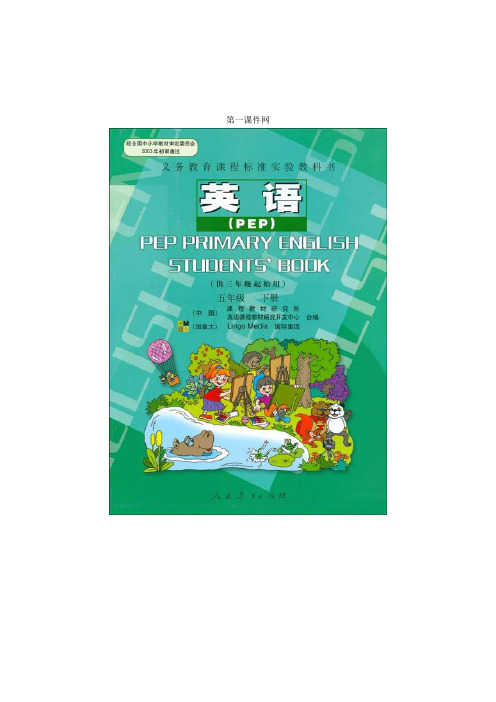
( 4)带问题阅读When does the policeman go to work/go to bed/eat…/play sports?然后检查学生的理解程度。
教师拿出带有have English class 8:30的卡片,并陆续的拿出其他的五张卡片。请六个同学上来分别抽一张卡片,看好后在交给老师,然后说:I usually eat dinner at 6:00.如果正确,就回到自己的位置上去,不正确留下来继续游戏。
一、导入新课
(1)Let’s try
教师放Let’s try部分的录音,让学生对新句型在听觉上有所感知,完成听音找对应作息时间表的练习。
教师板书:I get up at 6:30. I eat breakfast at 7:00. I go to bed at 7:00 in the morning. …等五个句子,其中有两句不符合实际情况的,有三句符合真实情况,让学生作出判断。也可让学生解释判断的依据。(2)活动结束时,教师说:You are right. I don’t go to bed so go to bed before 11: some people really go to bed at 7:00 inthe morning. Do you know why? Who are they? Let’s go and see.
( 5)放录音,跟读。适当解释对话中的词汇和语言,如:Can I ask you some questions? Thank you fou telling me about your day.
人教版PEP英语五年级下册《Unit1MydayPartB》(第一课时)教学设计
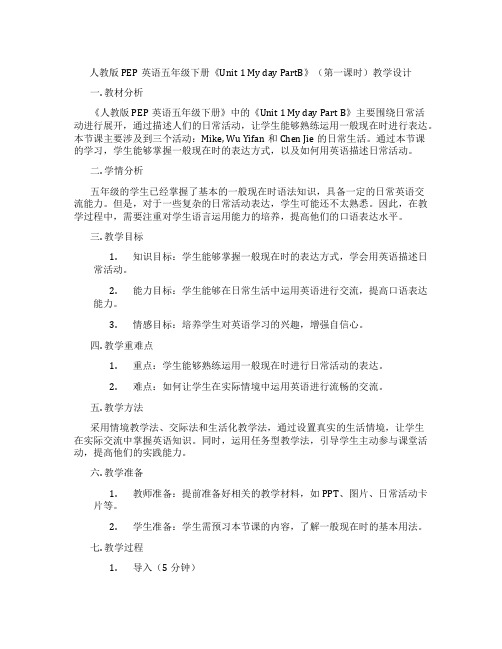
人教版PEP英语五年级下册《Unit 1 My day PartB》(第一课时)教学设计一. 教材分析《人教版PEP英语五年级下册》中的《Unit 1 My day Part B》主要围绕日常活动进行展开,通过描述人们的日常活动,让学生能够熟练运用一般现在时进行表达。
本节课主要涉及到三个活动:Mike, Wu Yifan和Chen Jie的日常生活。
通过本节课的学习,学生能够掌握一般现在时的表达方式,以及如何用英语描述日常活动。
二. 学情分析五年级的学生已经掌握了基本的一般现在时语法知识,具备一定的日常英语交流能力。
但是,对于一些复杂的日常活动表达,学生可能还不太熟悉。
因此,在教学过程中,需要注重对学生语言运用能力的培养,提高他们的口语表达水平。
三. 教学目标1.知识目标:学生能够掌握一般现在时的表达方式,学会用英语描述日常活动。
2.能力目标:学生能够在日常生活中运用英语进行交流,提高口语表达能力。
3.情感目标:培养学生对英语学习的兴趣,增强自信心。
四. 教学重难点1.重点:学生能够熟练运用一般现在时进行日常活动的表达。
2.难点:如何让学生在实际情境中运用英语进行流畅的交流。
五. 教学方法采用情境教学法、交际法和生活化教学法,通过设置真实的生活情境,让学生在实际交流中掌握英语知识。
同时,运用任务型教学法,引导学生主动参与课堂活动,提高他们的实践能力。
六. 教学准备1.教师准备:提前准备好相关的教学材料,如PPT、图片、日常活动卡片等。
2.学生准备:学生需预习本节课的内容,了解一般现在时的基本用法。
七. 教学过程1.导入(5分钟)教师通过提问方式引导学生回顾一般现在时的基本用法,如“What do you do?”“What does he/she do?”等。
然后,展示本节课的主题“My day”,激发学生的学习兴趣。
2.呈现(10分钟)教师通过PPT展示Mike, Wu Yifan和Chen Jie的日常生活图片,引导学生用英语描述他们的活动。
PEP五年级下unit5第四课时教学设计
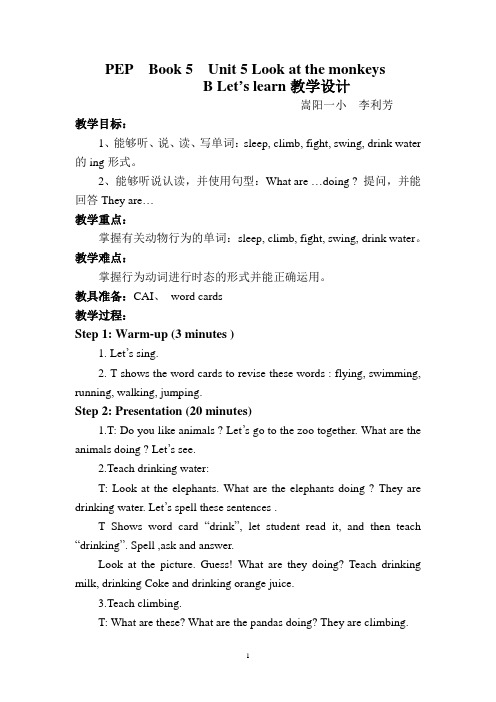
PEP Book 5 Unit 5 Look at the monkeysB Let’s learn教学设计嵩阳一小李利芳教学目标:1、能够听、说、读、写单词:sleep, climb, fight, swing, drink water 的ing形式。
2、能够听说认读,并使用句型:What are …doing ? 提问,并能回答They are…教学重点:掌握有关动物行为的单词:sleep, climb, fight, swing, drink water。
教学难点:掌握行为动词进行时态的形式并能正确运用。
教具准备:CAI、word cards教学过程:Step 1: Warm-up (3 minutes )1. Let’s sing.2. T shows the word cards to revise these words : flying, swimming, running, walking, jumping.Step 2: Presentation (20 minutes)1.T: Do you like animals ? Let’s go to the zoo together. What are the animals doing ? Let’s see.2.Teach drinking water:T: Look at the elephants. What are the elephants doing ? They are drinking water. Let’s spell these sentences .T Shows word card “drink”, let student read it, and then teach “drinking”. Spell ,ask and answer.Look at the picture. Guess! What are they doing? Teach drinking milk, drinking Coke and drinking orange juice.3.Teach climbing.T: What are these? What are the pandas doing? They are climbing.T Shows word card “climb”, let students read it, and then teach “climbing”. Spell it and read sentence together.T: Look at the picture. What are they doing? Teach the phrases climbing mountains and climbing a tree.3.Teach the word sleeping.T: What are these? What are the bears doing?T Shows word card “sleep”, let students read it, and then teach “sleeping”. Spell it and read sentence together.4. Teach the word fighting.T: What are these? What are the lions doing?T Shows word card “fight”, let students read it, and then teach “fighting”. Spell it and read sentence together.5. Teach the word swinging.T: What are the monkeys doing?T Shows word card “swing”, let students read it, and then teach “swinging”. Spell it and read sentence together.6. listen and read.Step 3: Practice (6 minutes)1.Guess! What’s missing?2.Guessing game . What are they doing?Step 4. Consolidation : (8 minutes)1. Ask and answer in groups of four.2.Describe the activities of animals.Step 5. Summary (3 minutes)What did you learn from this lesson ?Homework:1.Try to describe the animals using the words and sentences youhave learnt at home.2.Copy the words and sentences in part B Let’s learn.Board writing:Unit 5 Look at the monkeys(B Let’s learn) What are the elephants doing? They are drinking water.climbingsleepingfightingswinging。
五年级下册英语pep教案5篇
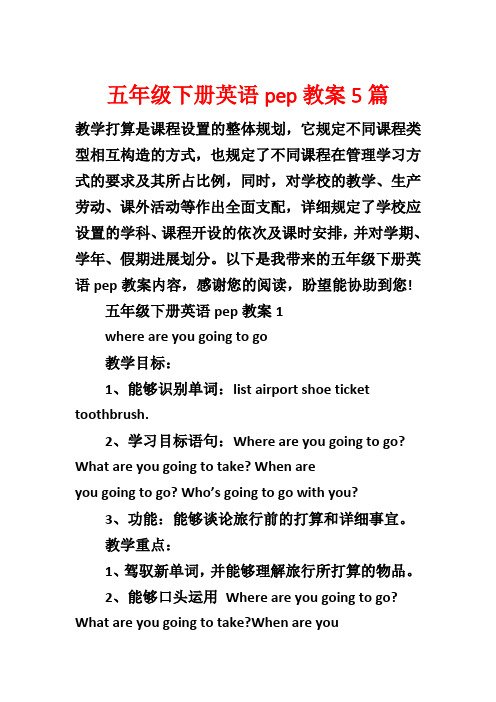
五年级下册英语pep教案5篇教学打算是课程设置的整体规划,它规定不同课程类型相互构造的方式,也规定了不同课程在管理学习方式的要求及其所占比例,同时,对学校的教学、生产劳动、课外活动等作出全面支配,详细规定了学校应设置的学科、课程开设的依次及课时安排,并对学期、学年、假期进展划分。
以下是我带来的五年级下册英语pep教案内容,感谢您的阅读,盼望能协助到您!五年级下册英语pep教案1where are you going to go教学目标:1、能够识别单词:list airport shoe ticket toothbrush.2、学习目标语句:Where are you going to go? What are you going to take? When areyou going to go? Who’s going to go with you?3、功能:能够谈论旅行前的打算和详细事宜。
教学重点:1、驾驭新单词,并能够理解旅行所打算的物品。
2、能够口头运用Where are you going to go? What are you going to take?When are yougoing to go to the airport?Who’s going to go to the airport?这类问句就详细信息提问。
教学难点:能够和同学用“where、what、when、who”这四个单词开头的疑问句谈论旅行前的准备。
教学用具:录音机、PPT教学过程:Step1、Warm-up师生之间相互问候Step2、Presentation Free talkT:the summer holiday is coming ,so Where are you going to go in yoursummerholidays? When are you going to go there? What are you going to take? Whatare you going to do there? Who is going to go with you ? (生逐一答复后,师总结):I thinkyou had a lovely time, Yes? 由此活动引出Where, When, What, Who?等特别疑问词,并带着同学们复习一般将来时的用法。
pep小学英语五下优秀说课稿

pep小学英语五下优秀说课稿PEP小学英语五年级下册的课程设计旨在培养学生的综合语言运用能力,通过各种教学活动激发学生的学习兴趣,提高学生的英语听说读写能力。
以下是一份PEP小学英语五年级下册的优秀说课稿:课程名称:PEP小学英语五年级下册教学目标:1. 知识与技能:学生能够掌握本单元的重点词汇、句型和语法结构。
2. 过程与方法:通过多种教学活动,如角色扮演、小组讨论等,提高学生的语言运用能力。
3. 情感态度与价值观:培养学生学习英语的兴趣,增强跨文化交流意识。
教学重点:- 词汇:本单元的核心词汇。
- 句型:日常交流中常用的句型结构。
- 语法:本单元涉及的语法点。
教学难点:- 语法结构的准确运用。
- 词汇在不同语境中的恰当使用。
教学方法:- 情景教学法:通过创设情境,让学生在实际语境中学习和使用英语。
- 合作学习法:鼓励学生进行小组合作,共同完成学习任务。
- 任务型教学法:设计具体的学习任务,引导学生在完成任务的过程中学习英语。
教学准备:- 教学PPT:包含本单元的重点词汇、句型和语法点。
- 教学音频:用于听力训练和发音模仿。
- 角色扮演卡片:用于角色扮演活动。
教学过程:1. 导入(Warming-up)- 通过播放与本单元主题相关的英文歌曲或视频,激发学生的兴趣。
- 简单复习上一单元的内容,为新课内容做铺垫。
2. 呈现(Presentation)- 利用PPT展示本单元的词汇和句型,通过图片、实物等辅助教学,帮助学生理解记忆。
- 通过听力练习,让学生熟悉词汇的发音和用法。
3. 练习(Practice)- 分组进行角色扮演,让学生在模拟的情境中使用新学的词汇和句型。
- 设计填空、连线等练习题,巩固学生对词汇和句型的掌握。
4. 应用(Application)- 组织小组讨论,让学生运用所学知识表达自己的观点。
- 通过游戏或竞赛形式,提高学生运用英语的积极性。
5. 总结(Summary)- 回顾本节课的重点内容,强调词汇和句型的用法。
- 1、下载文档前请自行甄别文档内容的完整性,平台不提供额外的编辑、内容补充、找答案等附加服务。
- 2、"仅部分预览"的文档,不可在线预览部分如存在完整性等问题,可反馈申请退款(可完整预览的文档不适用该条件!)。
- 3、如文档侵犯您的权益,请联系客服反馈,我们会尽快为您处理(人工客服工作时间:9:00-18:30)。
fly kites , swim , climb mountains, make a snowman ,skate,plant trees,go hiking…
(设计意图:通过口头作文,让学生进行一个头脑风暴,快速罗列出本单元的知识点。)
Step 3. Presentation:
1.Free talk 1:
Pair works: Do you like spring?
What can yoi?ct=50331=%D0%A1%D1%A7%C9%FA%D6%B2%CA%F7&in=30315&cl=2&lm=-1&st=&pn=2&rn=1&di=64198844295&ln=1901&fr=&fm=rs3&fmq=1331453793699_R&ic=&s=&se=&sme=0&tab=&width=&height=&face=&is=&istype=2#pn2&-1&di64198844295&objURLhttp%3A%2F%%2Fattachments%2F2009%2F03%2F193132_200903092147183M20D.jpg&fromURLhttp%3A%2F%%2F%3Fuid-193132-action-viewspace-itemid-318272&W480&H320&T8994&S86&TPjpg
二、教学课题
(一)知识与能力目标:
1、能够描述所喜欢的季节及原因。
2、能够询问各种季节的天气情况。
3、了解各地四季的气候情况和特点。
(二)情感目标:
1、培养学生热爱四季,热爱大自然的美好情感。
2、培养学生积极参与课堂活动的兴趣和能力。
(三)发展目标:
1、关注学生的小组合作学习,训练与他人沟通交流的能力。
S: My favourite season is ….
2.Let’s chant.【视频搜索】:/v?ct=301989888&rn=20&pn=0&db=0&s=8&word=pep%D0%A1%D1%A7%D3%A2%D3%EF%CE%E5%C4%EA%BC%B6%CF%C2%B2%E1%CA%D3%C6%B5&fr=ala0
四、教学策略
(一)教学方法
1、情景教学法:通过创设情景,让学生能够活学活用。
2、游戏教学法:通过游戏激发学生学习英语的兴趣。
3、小组活动学习法:开展小组对话和小组调查,让学生自主探究的学习。
(二)课前教具准备
1、教师准备有关季节和相关活动等单词的图片和单词卡。
2、VCD及教学课件。
3、教材配套的录音带。
In____, it is_____.
I can _________. I can _______, too.
I love _______! Do you like _______?
(提示单词和词组)
spring, summer,fall and winter.
warm, hot, cool , cold, sunny, rainy, windy , snowy
全国中小学“教学中的互联网搜索”优秀教学案例评选教案设计
佛山市顺德区伦教培教小学黄晓丹
一、教案背景
1、面向学生:小学五年级学生
2、学科:PEP小学五年级英语Unit2 My favourite season
3、课时:本单元第5课时
4、学生课前准备:
①预习课文:学读课文,并找出关键句子。
②上网搜索,了解更=%C7%EF%CC%EC%B7%E7%BE%B0%CD%BC%C6%AC&in=12798&cl=2&lm=-1&st=-1&pn=27&rn=1&di=6570544500&ln=1998&fr=&fm=result&fmq=1331438724516_R&ic=0&s=0&se=1&sme=0&tab=&width=&height=&face=0&is=&istype=2#pn27&-1&di6570544500&objURLhttp%3A%2F%%2FUploadFiles%2FSoft6%2F2010%2F5%2F201005050018297875.jpg&fromURLhttp%3A%2F%%2Fitem%2F402214.aspx&W1000&H775&T9401&S246&TPjpg
2、让学生学会通过翻阅书籍或互联网搜索解决问题的能力。
3、学习各个地方各个季节的风俗习惯,培养跨文化意识。
三、教材分析
“Unit 2 My favourite season”是人民教育出版社出版的三年级起点的教材。本课时是五年级上册,第二单元的第五课时讨论最喜欢季节的内容。这节课的重点是学生运用已经掌握的有关季节的单词:spring, summer, fall, winter以及动词短语swim, plant trees, fly kites, make a snowman, skate等来询问他人喜欢的季节及原因,学生正确使用句型:Why do you like…? Because I can…。本节课的难点是如何正确询问对方喜欢某季节的原因。
出示PPT,学生汇报上一节课的课后作业:口头作文My favourite season
My favourite season
There are four seasons in a year: spring, summer,fall and winter.
My favourite s=%B6%AC%CC%EC%B7%E7%BE%B0%CD%BC%C6%AC&in=13482&cl=2&lm=-1&st=-1&pn=30&rn=1&di=130654380000&ln=2000&fr=&fm=result&fmq=1331438833364_R&ic=0&s=0&se=1&sme=0&tab=&width=&height=&face=0&is=&istype=2#pn31&-1&di99832668015&objURLhttp%3A%2F%%2Fuploads%2Fallimg%2F111113%2F53169-1111130gp860.jpg&fromURLhttp%3A%2F%%2Fpsd%2F201111%2F124064.html&W1000&H659&T9520&S114&TPjpg
五、教学过程Step 1. Warm源自up:1.Free talk:
T: Good morning. What day is it today?
S: Good morning. It’s ….
T: What’s the weather like today?
S: It’s ….
T: By the way, what’s your favourite season?
(设计意图:讨论各个季节的气候,为下面对话的开展做好铺垫。)
2.Free talk 2:
T: I like spring best. What can we do in spring?(出示PPT图片,学生回答复习上一节课词组。)
